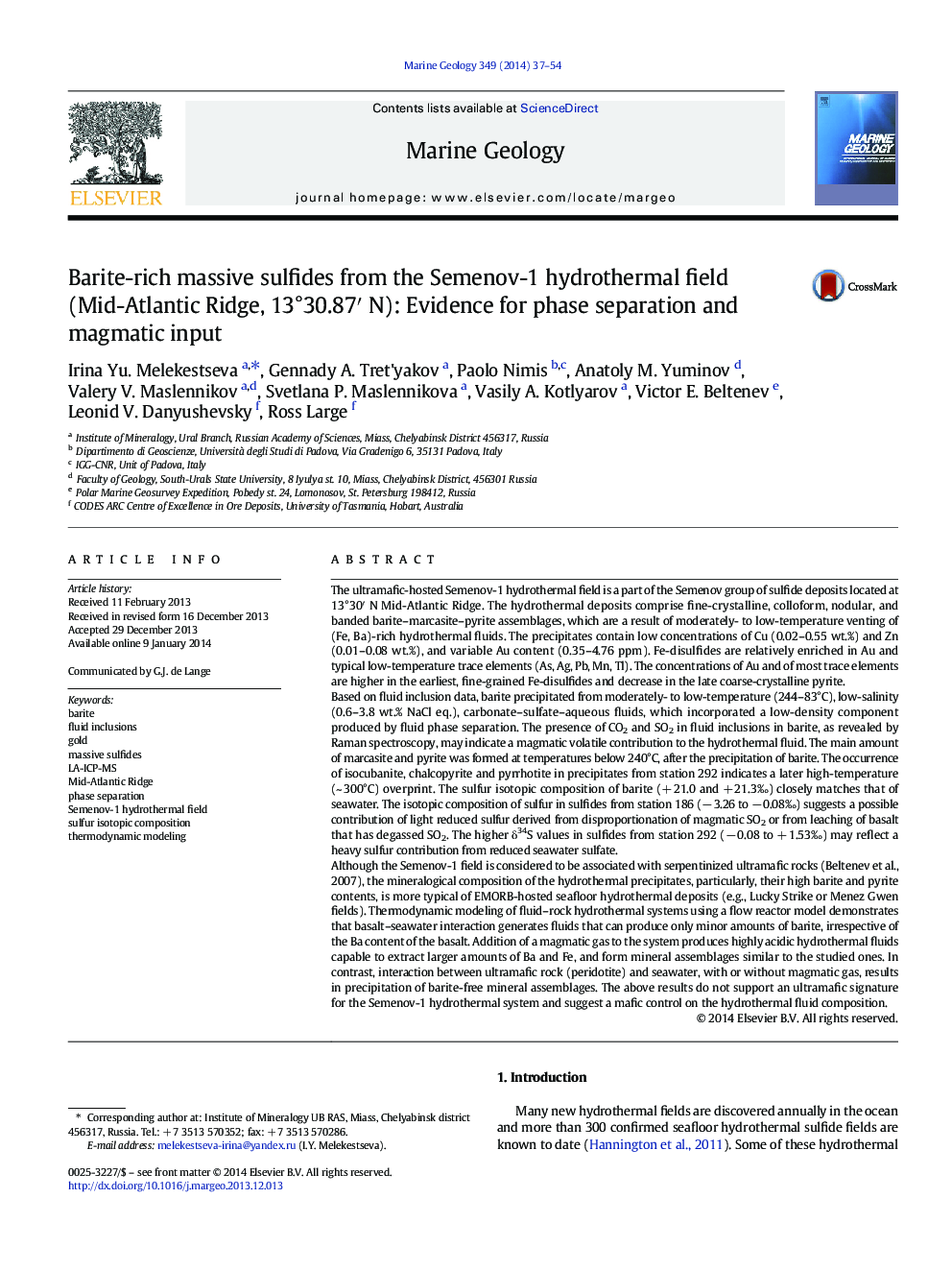| کد مقاله | کد نشریه | سال انتشار | مقاله انگلیسی | نسخه تمام متن |
|---|---|---|---|---|
| 4718310 | 1639103 | 2014 | 18 صفحه PDF | دانلود رایگان |

• Massive sulfides from the Semenov-1 field are rich in barite.
• They were deposited from moderate- to low-T and low-salinity fluid.
• Low salinity is inferred to result from vent fluid phase separation.
• Barite-rich sulfides requires mafic substrate and magmatic volatile contribution.
• First generations of sulfides are enriched in Au and other trace elements.
The ultramafic-hosted Semenov-1 hydrothermal field is a part of the Semenov group of sulfide deposits located at 13°30′ N Mid-Atlantic Ridge. The hydrothermal deposits comprise fine-crystalline, colloform, nodular, and banded barite–marcasite–pyrite assemblages, which are a result of moderately- to low-temperature venting of (Fe, Ba)-rich hydrothermal fluids. The precipitates contain low concentrations of Cu (0.02–0.55 wt.%) and Zn (0.01–0.08 wt.%), and variable Au content (0.35–4.76 ppm). Fe-disulfides are relatively enriched in Au and typical low-temperature trace elements (As, Ag, Pb, Mn, Tl). The concentrations of Au and of most trace elements are higher in the earliest, fine-grained Fe-disulfides and decrease in the late coarse-crystalline pyrite.Based on fluid inclusion data, barite precipitated from moderately- to low-temperature (244–83°С), low-salinity (0.6–3.8 wt.% NaCl eq.), carbonate–sulfate–aqueous fluids, which incorporated a low-density component produced by fluid phase separation. The presence of CO2 and SO2 in fluid inclusions in barite, as revealed by Raman spectroscopy, may indicate a magmatic volatile contribution to the hydrothermal fluid. The main amount of marcasite and pyrite was formed at temperatures below 240°С, after the precipitation of barite. The occurrence of isocubanite, chalcopyrite and pyrrhotite in precipitates from station 292 indicates a later high-temperature (~ 300°С) overprint. The sulfur isotopic composition of barite (+ 21.0 and + 21.3‰) closely matches that of seawater. The isotopic composition of sulfur in sulfides from station 186 (− 3.26 to − 0.08‰) suggests a possible contribution of light reduced sulfur derived from disproportionation of magmatic SO2 or from leaching of basalt that has degassed SO2. The higher δ34S values in sulfides from station 292 (− 0.08 to + 1.53‰) may reflect a heavy sulfur contribution from reduced seawater sulfate.Although the Semenov-1 field is considered to be associated with serpentinized ultramafic rocks (Beltenev et al., 2007), the mineralogical composition of the hydrothermal precipitates, particularly, their high barite and pyrite contents, is more typical of EMORB-hosted seafloor hydrothermal deposits (e.g., Lucky Strike or Menez Gwen fields). Thermodynamic modeling of fluid–rock hydrothermal systems using a flow reactor model demonstrates that basalt–seawater interaction generates fluids that can produce only minor amounts of barite, irrespective of the Ba content of the basalt. Addition of a magmatic gas to the system produces highly acidic hydrothermal fluids capable to extract larger amounts of Ba and Fe, and form mineral assemblages similar to the studied ones. In contrast, interaction between ultramafic rock (peridotite) and seawater, with or without magmatic gas, results in precipitation of barite-free mineral assemblages. The above results do not support an ultramafic signature for the Semenov-1 hydrothermal system and suggest a mafic control on the hydrothermal fluid composition.
Journal: Marine Geology - Volume 349, 1 March 2014, Pages 37–54